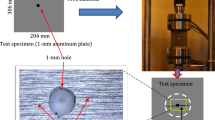Abstract
Surface response to excitation (SuRE) method was originally developed for structural health monitoring (SHM) applications. SuRE was used to evaluate the performance of completed milling operations. The method generates surface waves on the plate and studies the spectrum changes at selected points to detect defects and change of compressive forces. In this study, the length, depth, and width of a slot were changed step by step. The surface of the aluminum plate was excited in the 20–400 kHz range with a piezoelectric element. A laser scanning vibrometer was used to monitor the vibrations at the predetermined grid points after the dimensions of the slot were changed methodically. The frequency spectrums of measured vibrations were calculated by using the Fast Fourier Transformation (FFT). The sums of the squares of the differences (SSD) of the spectrums were calculated to evaluate the change of the spectrums. The SuRE method was able to determine if the dimensions were changed in each case at all the selected points. The scanning laser vibrometer is not feasible to be used at the shop floor. However, the study demonstrated that a piezoelectric element attached to any of the grid points would be able to evaluate the completed machining process.
Similar content being viewed by others
References
Kalvoda T, Hwang YR (2010) A cutter tool monitoring in machining process using Hilbert–Huang transform. Int J Mach Tools Manuf 50(5):495–501
Lu MC, Wan BS (2013) Study of high-frequency sound signals for tool wear monitoring in micromilling. Int J Adv Manuf Technol 66(9–12):1785–1792
Nikranjbar A, Atai AA (2013) Online model-based milling process condition monitoring. Int J Mechatronics Manuf Syst 6(2):195–212
Hase A, Wada M, Koga T, Mishina H (2014) The relationship between acoustic emission signals and cutting phenomena in turning process. Int J Adv Manuf Technol 70(5–8):947–955
Dinakaran D, Sampathkumar S, Sivashanmugam N (2009) An experimental investigation on monitoring of crater wear in turning using ultrasonic technique. Int J Mach Tools Manuf 49(15):1234–1237
Lamraoui M, Thomas M, El Badaoui M, Girardin F (2014) Indicators for monitoring chatter in milling based on instantaneous angular speeds. Mech Syst Signal Process 44(1):72–85
Hsieh WH, Lu MC, Chiou SJ (2012) Application of backpropagation neural network for spindle vibration-based tool wear monitoring in micro-milling. Int J Adv Manuf Technol 61(1–4):53–61
Cuš F, župerl U (2011) Real-time cutting tool condition monitoring in milling. Strojniškivestnik-J Mech Eng 57(2):142–150
Tangjitsitcharoen S, Saksri T, Ratanakuakangwan S (2013) Advance in chatter detection in ball end milling process by utilizing wavelet transform. J Intell Manuf 26(3):485–499
Cao H, Lei Y, He Z (2013) Chatter identification in end milling process using wavelet packets and Hilbert–Huang transform. Int J Mach Tools Manuf 69:11–19
Kalvoda T, Hwang YR (2010) Analysis of signals for monitoring of nonlinear and non-stationary machining processes. Sens Actuators A: Phys 161(1):39–45
El Ouafi A, Barka N (2014) An ANN based multi-sensor integration approach for in-process monitoring of product quality in turning operations. J Autom Control Eng 2(3):289–293
Samadani M, Behbahani S, Nataraj C (2013) A reliability-based manufacturing process planning method for the components of a complex mechatronic system. Appl Math Model 37(24):9829–9845
Brecher C, Quintana G, Rudolf T, Ciurana J (2011) Use of NC kernel data for surface roughness monitoring in milling operations. Int J Adv Manuf Technol 53(9–12):953–962
Huang PB (2014) An intelligent neural-fuzzy model for an in-process surface roughness monitoring system in end milling operations. J Intell Manuf 1–12. doi:10.1007/s10845-014-0907-6
Marinescu I, Axinte DA (2011) An automated monitoring solution for avoiding an increased number of surface anomalies during milling of aerospace alloys. Int J Mach Tools Manuf 51(4):349–357
Quintana G, Garcia-Romeu ML, Ciurana J (2011) Surface roughness monitoring application based on artificial neural networks for ball-end milling operations. J Intell Manuf 22(4):607–617
Bisu CF, Zapciu M, Cahuc O, Gérard A, Anica M (2012) Envelope dynamic analysis: a new approach for milling process monitoring. Int J Adv Manuf Technol 62(5–8):471–486
Fekrmandi H, Rojas J, Campbell J, Tansel IN, Kaya B, Taskin S (2014) Inspection of the integrity of a multi-bolt robotic arm using a scanning laser vibrometer and implementing the Surface Response to Excitation Method (SuRE). Int J Progn Health Manag 5.1:1–10
Fekrmandi H, Rojas J, Tansel IN, Yapici A, Uragun B (2015) Investigation of the computational efficiency and validity of the surface response to excitation method. Measurement 62:33–34
Tansel IN, Yapici A (2013) Part based process performance monitoring (PbPPM). J Manuf Process 15(3):329–337
Author information
Authors and Affiliations
Corresponding author
Rights and permissions
About this article
Cite this article
Fekrmandi, H., Unal, M., Baghalian, A. et al. A non-contact method for part-based process performance monitoring in end milling operations. Int J Adv Manuf Technol 83, 13–20 (2016). https://doi.org/10.1007/s00170-015-7523-2
Received:
Accepted:
Published:
Issue Date:
DOI: https://doi.org/10.1007/s00170-015-7523-2




